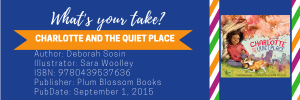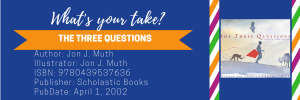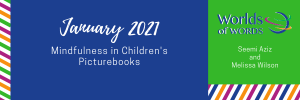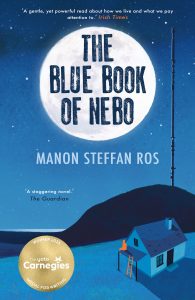 The Blue Book of Nebo by Manon Steffan Ros is a profoundly moving young adult novella. Originally written in Welsh, it is a gentle and raw tale of a family’s survival in an isolated house in Northwest Wales after some kind of horrific disaster. The story is told through alternate journal entries written by Dylan, a young teenager, and his mother, Rowenna. They share a journal, which they call The Blue Book of Nebo, but they agree not to read each other’s entries. Continue reading
The Blue Book of Nebo by Manon Steffan Ros is a profoundly moving young adult novella. Originally written in Welsh, it is a gentle and raw tale of a family’s survival in an isolated house in Northwest Wales after some kind of horrific disaster. The story is told through alternate journal entries written by Dylan, a young teenager, and his mother, Rowenna. They share a journal, which they call The Blue Book of Nebo, but they agree not to read each other’s entries. Continue reading
Melissa Wilson


WOW Dozen: Young Adult Fiction Featuring Jewish Adolescents
By Melissa Wilson, Leeds Trinity University, Leeds, West Yorkshire, UK
Many young adult books about Jews or being Jewish are set in the Holocaust (Shoah) or in Israel. These settings limits readers from building connections to Jews who are currently living in the diaspora (not living in Israel). This WOW Dozen highlights young adult realistic fiction featuring these Jews. Each novel shows Jewish younger people living lives not directly connected to the Shoah or to the Middle East. This text set illustrates that diaspora Jews, like all cultural groups, are not a monolith. We live all over the world, speak different languages, and have varying degrees of religious orthodoxy. Yet there are ties that bind all of us, ties of traditional languages (Hebrew, Yiddish, Ladino), otherness, and a non-Christian world view. Enjoying and transacting with these texts will help students to connect with Jews and Jewish culture in the here and now. Most importantly, these connections will challenge the entrenched antisemitism that infects our American culture. Continue reading

MTYT: Charlotte and the Quiet Place
by Seemi Aziz, University of Arizona, Tucson, AZ, and Melissa Wilson, Leeds Trinity University, Leeds, West Yorkshire, UK
Rounding off the first month of 2021, we discuss Charlotte and the Quiet Place and take one last look at how mindfulness may help us during this stressful times.
The texts discussed this month may offer readers (and listeners) some peace during these most turbulent times. They are books that thematically deal with the concept of mindfulness through a narrative. There are many new books being marketed for children that are guides to mindfulness practices. A quick browse on Amazon yields pages of “activity books” that offer to help children process feelings, step-by-step manuals for doing meditation with children, and even books to help teach children “growth mindsets”.
Sometimes the best way to deal with a difficult present and an uncertain future is to lose yourself in someone else’s story. Through reading, or being read to, you can experience different ways of living on a deep level. These experiences can give much succor and “practice runs” at figuring out how to live a life well.

MTYT: The Three Questions
by Seemi Aziz, University of Arizona, Tucson, AZ, and Melissa Wilson, Leeds Trinity University, Leeds, West Yorkshire, UK
This week Seemi and Melissa give their takes on a classic picturebook, The Three Questions, that helps children understand mindfulness.

MTYT: After the Fall: How Humpty Dumpty Got Back Up Again
by Seemi Aziz, University of Arizona, Tucson, AZ, and Melissa Wilson,Leeds Trinity University, Leeds, West Yorkshire, UK
Happy New (Gregorian) Year! To welcome in 2021, we, Seemi and Melissa, are going to explore the concept of mindfulness through critical readings of powerful children’s picture books. We have come to understand that visual and written narratives work simultaneously to add to the understanding and comprehension of children and adults in the present, increasingly visual, world. As the worldwide pandemic of Coronavirus rages on, we all need resources to cope with constant disruptions and uncertainty. Mindfulness is a resource that may benefit both adults and children and one that can be explored through picture books.
“Mindfulness is awareness that arises through paying attention, on purpose, in the present moment, non-judgmentally… it’s about knowing what is on your mind.” – Jon Kabat-Zinn
The above quote nicely defines mindfulness for our purposes. Rooted in ancient religious practices, mindfulness came to the United States in the 1970s as a secular way to help people through the work of Kabat-Zinn. In the ensuing half century, the concept has become part of western culture.
Throughout this month we will discuss specific picture books to explore mindfulness with children. The specific texts are: After the Fall: How Humpty Dumpty got back up again by Dan Santat, Charlotte and the Quiet Place by Deborah Sosin, and The Three Questions by Jon Muth. As we unravel the narratives, we will add other titles that reinforce the concept of mindfulness. Continue reading

Notes from a Small Island: The Lie Tree
by Melissa Wilson, Leeds Trinity University, Leeds, West Yorkshire, UK
 This is my last week blogging from a small and crowded island; the book I am discussing is called The Lie Tree, written by Frances Hardinge, who is a popular and well received author in the U.K. Like the other texts I have discussed, this one won an award, The Costa Book Award in 2015, and is in the fantasy genre. And like the other two novels, it is being marketed for young adults, although I question this designation. Though the protagonist is 14 years old, she is a chaste and sexless adolescent, and I subscribe to what Karen Coats has said about YA fiction: what makes it YA is the sex. Continue reading
This is my last week blogging from a small and crowded island; the book I am discussing is called The Lie Tree, written by Frances Hardinge, who is a popular and well received author in the U.K. Like the other texts I have discussed, this one won an award, The Costa Book Award in 2015, and is in the fantasy genre. And like the other two novels, it is being marketed for young adults, although I question this designation. Though the protagonist is 14 years old, she is a chaste and sexless adolescent, and I subscribe to what Karen Coats has said about YA fiction: what makes it YA is the sex. Continue reading

Notes from a Small Island: The Knife of Never Letting Go
By Melissa Wilson
 This week’s text is a young adult novel by Patrick Ness called The Knife of Never Letting Go. While searching for book reviews I saw that its genre is called “speculative fiction,” a term with which I am unfamiliar. What I discovered with more searching is that it is a literary category that comprises science fiction and fantasy, but it is a bit more Continue reading
This week’s text is a young adult novel by Patrick Ness called The Knife of Never Letting Go. While searching for book reviews I saw that its genre is called “speculative fiction,” a term with which I am unfamiliar. What I discovered with more searching is that it is a literary category that comprises science fiction and fantasy, but it is a bit more Continue reading

Notes from a Small Island: Examining Recent Award-Winning Books from the United Kingdom
By Melissa Wilson
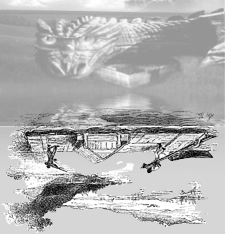 As the purpose of World of Words is to “to build bridges across global cultures through children’s and adolescent literature,” I would like to use this month’s WOW Currents to employ adolescent literature from the United Kingdom as a way to examine the similarities and differences of cultures from two different countries that share the same language (although the English may not agree about the “same language” assertion). Continue reading
As the purpose of World of Words is to “to build bridges across global cultures through children’s and adolescent literature,” I would like to use this month’s WOW Currents to employ adolescent literature from the United Kingdom as a way to examine the similarities and differences of cultures from two different countries that share the same language (although the English may not agree about the “same language” assertion). Continue reading

